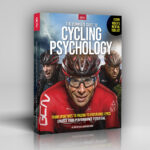Pain is an inevitable part of endurance-sport training and racing, and at the same time, the greatest obstacle endurance athletes face as they pursue their goals. As a human being, you are wired to avoid pain at all costs. From an evolutionary perspective, when humans felt pain on the Serengeti 250,000 years ago (when we first became Homo Sapiens), it was an essential tool for our survival, letting them know when their lives were in danger, thus ensuring that they propagated the species.
Unfortunately, what worked for so many eons does you no good as you strive for PRs in running, cycling, swimming, triathlon, and other endurance races. The right kind of pain is valuable to you in several ways. First, committing to an endurance sport is about pushing outside of your comfort zone and seeing what you are capable of physically and psychologically. Let’s be honest here, if it didn’t hurt, you wouldn’t run, bike, swim, XC ski, or what-have-you for so long or so far, well beyond it being fun. Second, pain can play an essential role in providing you with information about your training and race performances including your effort, the intensity of your training, and whether you can hold a certain pace to the finish. The problem is that your primitive brain and body don’t know the difference between the life-threatening pain that comes from tracking a gazelle for 25 miles before killing it (and needing to carry it home!) back when we were cavepeople and the life-affirming (though decidedly unpleasant) pain you experience during the last of 8×400 intervals, the last three miles of a marathon, or the last ten miles of a century ride.
Whether you use pain to help you thrive and strive toward your endurance-sport goals or you succumb to the pain that helped us survive for so many millennia depends on your understanding of pain and whether you can gain mastery over it. In the former case, you’re attempting to resist not only 100s of 1000s of years since we became human beings, but millions of years of evolution since living creatures climbed out of the primordial muck as reptiles. In the latter case, you might consider taking up golf or bowling.
Perspective on Pain
Using pain to your advantage starts with gaining a realistic perspective on what pain really is. A number of years ago, I was out for a long, hilly (about 6000 vertical) ride with friends north of San Francisco. At the end of the six-hour ride, one of the guys said, “That was a sufferfest!” Here is where some perspective on pain is needed. You need to understand the difference between suffering, pain, and physical discomfort.
Here is a simple fact: What you experience in your endurance-sport training is not suffering (I think we use such language because it makes us feel tough and heroic). I used to give talks to the Leukemia & Lymphoma Society Team in Training groups and those talks put endurance-sport pain in perspective for me. People with cancer suffer because what they feel is severe, long lasting, life threatening, and often uncontrollable. What you feel when you exert yourself in training and races is not really pain. Real pain comes from injuries. This pain is similar to suffering, but injury pain—though sometimes severe—is not life threatening, typically doesn’t last that long, and can be controlled much more easily.
What you really feel in training and races is discomfort. It hurts and it interferes with your training and competitive efforts, but you can ease the discomfort by slowing down or stopping. For simplicity’s sake, though, let’s continue to call what we experience pain because it is commonly used, it is only four letters, and it makes us feel a little bit heroic. Plus, “That was a discomfort fest!” just doesn’t have the same ring to it. But even though we’ll call it pain, you now know what it really is. This perspective takes the first bit of edge off the pain you experience training and races. It also sets the stage for additional strategies for turning down the volume of your endurance-sport pain to a more manageable level.
Interpreting Pain
The next step to overcoming pain is to understand that pain isn’t just a physical experience that you have to tolerate in your training and races. Pain also has a major psychological component to it; how you think about it and the emotions you connect to it affect the pain you feel. How you interpret your pain either propels you to new heights of performance or drags you down to new depths of struggle. Pain can hurt your motivation, reduce your confidence, increase your stress, and distract you from your training or competitive focus. Conversely, if you can interpret your pain in a positive way, your pain will feel, well, less painful.
Pain as Your Enemy
Pain becomes your enemy, first, when you start with negative perceptions about pain like, “Pain is bad,” “Pain means I am weak,” and “Pain means I will fail.” This attitude toward pain puts you in an unproductive mindset in which your first experience of pain in training or competition sets off a downward psychological and physical spiral. When you are doing those 10×100s in the pool, those hill repeats on your bike, or that 30-minute tempo run and you start thinking, “I hate this. What am I doing out here? Is this really worth it?,” this defeatist orientation actually increases the pain you feel. Your thinking goes to the “dark side,” your motivation declines, you experience unhelpful emotions, your focus turns away from your efforts and onto the pain. With this reaction, your ability to fight through the pain decreases, your efforts lessen, and, as a result, you limit the benefits and satisfaction you might gain from your training and race performances.
Second, the emotions that you connect with your pain have a significant impact on how much pain you feel. I’m sure you’ve had the experience in a race when you start to hurt. You begin to get frustrated that you won’t reach your goal time. You get angry at yourself for not having trained harder. You may even despair of your ability to finish. When you connect these negative emotions with your pain in training or a race, you feel more pain. Between the pain you feel, your negative self-talk, and the negative emotions, you have little chance of giving your best effort in training or being successful in races.
Pain as Your Ally
Making pain your ally starts with accepting that pain is a normal and important part of training and competition—“no pain, no gain,” as the saying goes. Because pain tells you that you’re working hard toward your goals, you can embrace the pain you feel in training and races. It also involves experiencing your pain as objectively as possible and using it as information to get the most out of your efforts. Pain tells you how hard you are working and whether the discomfort you are feeling is due to exertion or injury. With this information, you can adjust your pace, modify your technique, change your body position, shift your tactics (or stop if the pain is due to an injury). Making these changes will help you reduce your pain and also maximize your performances.
You can also take active physical steps to reduce your pain. When your body begins to struggle, it tries to protect itself from the pain by tightening up. Your body doesn’t realize that this only makes it worse, so you need to tell it relax. Simple techniques during training and races, such as deep breathing, raising and lowering your shoulders every few miles, swinging your arms, shaking out your hands, and keeping your face relaxed, can make a huge difference in how your body responds to pain.
What you say to yourself about the pain you feel also influences its intensity. Just as negative self-talk can increase the pain you feel, positive self-talk, such “I’m getting stronger with every step,” “This is making me tougher,” and “I’m working hard toward my goals,” can have the opposite effect, actually reducing your pain. It also has psychological benefits including a greater sense of control, increased motivation, greater confidence, better focus, and more positive emotions.
Much as negative emotions increase the experience of pain, positive emotions can reduce your perception of pain. Connecting positive emotions such as excitement, pride, inspiration, and satisfaction with the pain you feel in training and races reduces the pain and makes it more tolerable. Positive emotions create more positive self-talk and have other psychological advantages, such as greater motivation and confidence. Physiologically, positive emotions release endorphins (neurochemicals that act as our internal painkillers) which not only reduce the perception of pain, but actually lessen the physical pain.
Inspiration is my favorite positive emotion to experience when I’m training and racing. I view the pain I feel as part of an epic challenge to overcome my perceived limitations and achieve my goals. My pain tells me I’m working hard and making progress toward my endurance-sport dreams and that fuels my passion that motivates me to be an endurance-sport athlete in the first place. To that end, I have a two-pronged strategy that combines generating positive self-talk and positive emotions. When I’m in a lot of pain, for example, riding up the Seven Sisters in Marin County or doing laps at Aquatic Park in San Francisco, I smile and say, “Money in the bank, baby, money in the bank” (you have to say “baby” or it won’t work!). Smiling creates positive emotions and releases those pain-killing endorphins, and the self-talk tells me that I am making deposits on my fitness that I’ll be able to withdraw in races (unlike debit cards, endurance sports don’t have overdraft protection).
Another useful way to respond to your pain is to realize that others around you are in pain too. It can be frustrating late in a race to be hurting pretty badly and looking over at other competitors who appear to be having no difficulty at all. Don’t be fooled by this! You can’t see inside of them and experience their discomfort. On the outside, you probably look cool, calm, and collected too, even though inside you may be in agony. If you’re in pain, the chances are those around you are too. Take comfort in knowing that. Remember, misery loves company.
Finally, perhaps the greatest lesson I have learned as both a sport psychologist and an endurance athlete is this: The physical pain you feel in training and races in no way compares to the emotional pain you will feel if you don’t achieve your goals because you didn’t master the pain in the first place.
Do you want to take the next step in training your tri-mind to perform your best in training and on race day? Here are four options for you:
- Read my latest mental training book: Train Your Mind for Athletic Success: Mental Preparation to Achieve Your Triathlons Goals.
- Listen to my Train Your Mind for Athletic Success
- Take a look at myonline mental training courses.
- Schedule a 1:1 session with me.






